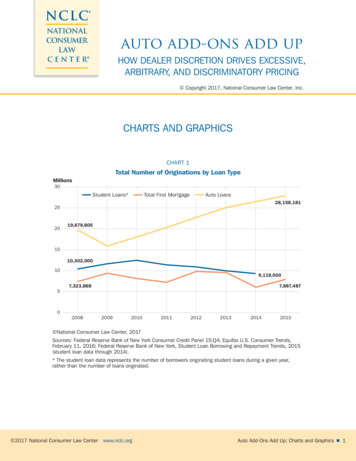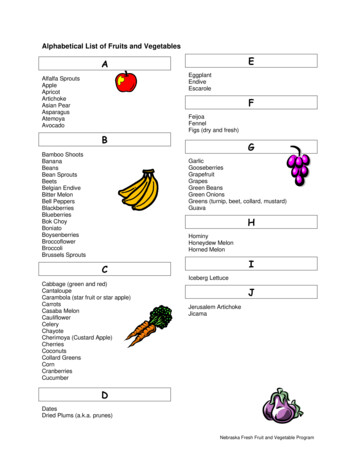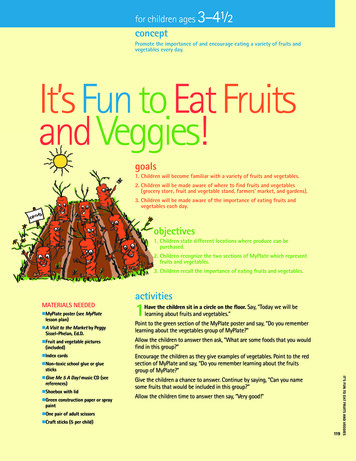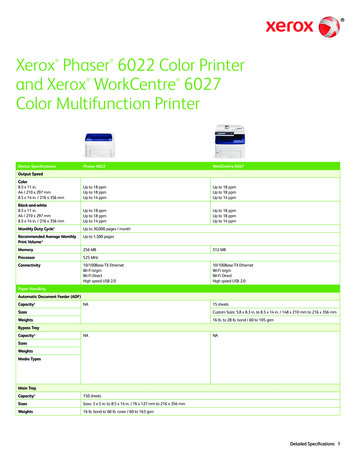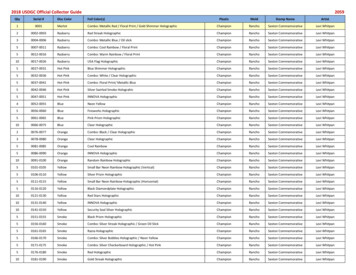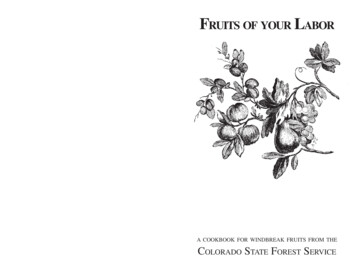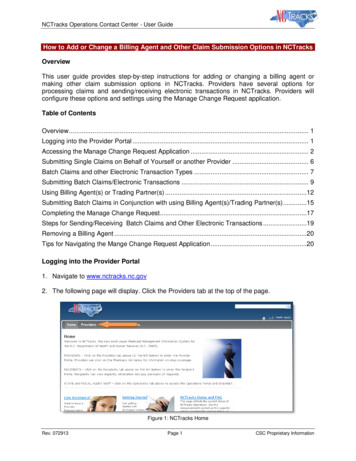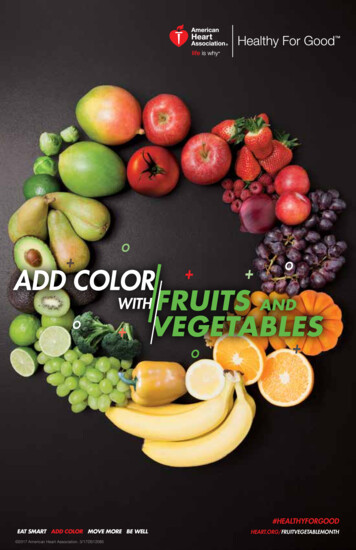
Transcription
ADD COLORWITH FRUITS ANDVEGETABLES#HEALTHYFORGOODEAT SMART ADD COLOR MOVE MORE BE WELL 2017 American Heart Association. 3/17DS12085HEART.ORG/FRUITVEGETABLEMONTH
Fruits and vegetables are a key part of an overall healthy eating plan.They’re also delicious, colorful, versatile, convenient, affordable andfun. This guide includes great tips, resources and recipes to help youadd color with heart-healthy fruits and vegetables.
WHAT YOU’LL FIND IN THIS GUIDE:How to Eat More Fruits and VegetablesWhat’s a Serving?So Many BenefitsBuild a Better SandwichSeasons of EatingKeep It FreshBudget BasicsHealthy PreparationMastering the MythsHealthy Recipes Rosemary Balsamic Roasted Vegetables Frozen Yogurt BarkKids’ Zone Fun Facts Monthly Calendar Fruit and Veggie Challenge
HOW TOEAT MORE FRUITS AND VEGETABLESYou can easily add color to every meal and snack. Try some of these practicaltips that don’t require a lot of changes to the way your family eats: P ack portable, easy-to-eat fruits and veggies in your work or school bag,and avoid vending machine temptations. Add frozen peas or broccoli to rice when it’s almost done cooking. Add extra veggies to soups and stews. H ave a meatless meal once a week. Think vegetable lasagna, Portobellomushroom “burgers” or grilled veggie kabobs. F ill out a sandwich with fruits and veggies. Try sliced or shredded vegetableslike beets, carrots, celery, cucumbers, onions, peppers, radishes, tomatoesand zucchini and/or sliced fruits like apple, avocado and pear. K eep frozen and canned fruits and vegetables on hand for when you needto throw together a meal in a hurry. Compare food labels and choose itemswithout sauces and too much sodium. Work fruits and vegetables into your family’s favorite dishes. M ake adding fruits and veggies to meals a snap by cutting them up andkeeping them in the fridge. They’ll also be handy for snacking! W hen eating out, ask if you can substitute a fruit cup or side salad for friesand other less-healthy sides. Top yogurt, oatmeal and cereal with berries or sliced fruit. M ake fruit popsicles. Freeze 100 percent juice or pureed fruit in an ice trayor popsicle mold. Add spinach, peppers or mushrooms into scrambled eggs and omelets. F or snack time, keep fresh fruit and pre-chopped or no-chop veggies (suchas baby carrots, cherry tomatoes and sugar snap peas) on hand, as well assingle-serve containers of raisins or applesauce. Your kids may grab theminstead of less-healthy snacks if they’re readily available. E njoy fruit for dessert most days and limit traditional desserts tospecial occasions. M ake it fun for kids to try new fruits and veggies. Let them pick out a newfruit or vegetable in the grocery store each week, and figure out togetherhow to cook or prepare it. You might end up expanding your palate as well! E at the rainbow: A fun and tasty way to make sure your family is eating agood variety of fruits and vegetables is to eat as many different colors asyou can each day. Keep a bowl of whole fruit handy on the desk, table or countertop.
WHAT’SA SERVING?FRUITSVEGETABLESONE MEDIUM FRUITRAW LEAFY VEGETABLE4 servings per day About the sizeof your fist5 servings per day 1 CUP 1/2 CUPFRESH, FROZEN OR CANNEDFRESH, FROZEN OR CANNEDDRIEDVEGETABLE JUICE 1/2 CUP 1/4 CUPFRUIT JUICE 1/4 CUP 1/2 CUP*based on a 2,000 calorie eating patternThe good news is eating the right amount of fruits and vegetables doesn’t haveto be complicated. Here are some examples of about one serving:FRUITSVEGETABLESApple, pear, orange, peach ornectarine: 1 mediumBell pepper: Half of a largeAvocado: Half of a mediumBroccoli or cauliflower: 5 to 8 floretsBanana: 1 small (about 6” long)Carrot: 6 baby or 1 whole medium (6to 7” long)Grapefruit: Half of a medium(4” across)Corn: 1 small ear (6” long) or half ofa large ear (8 to 9” long)Grape: 16Leafy vegetable: 1 cup raw or ½ cupcooked (lettuce, kale, spinach, greens)Kiwifruit: 1 mediumMango: Half of a mediumMelon: Half-inch thick wedge of slicedwatermelon, honeydew, cantaloupePineapple: ¼ of a mediumStrawberry: 4 largePotato: Half of a medium (2½ to3” across)Squash, yellow: Half of a smallSweet potato: Half of a large(2¼” across)Zucchini: Half of a large (7 to 8” long)
SO MANYBENEFITSFruits and vegetables are an important part of an overall healthy eatingplan because they’re typically high in vitamins, minerals and fiber and low incalories and saturated fat. Most fruits and vegetables also have no or littlesodium. Avocados are even a good source of healthy fats your body needs.Eating a variety of fruits and vegetables may help you control your weight andblood pressure and reduce your risk of heart disease and stroke. They providekey nutrients many of us don’t get enough of, such as calcium, fiber, iron,potassium, and vitamins A and C.AVO-FREDO ZOODLES - AVOCADO ALFREDO ZUCCHINI NOODLESMakes 4 servingsINGREDIENTS4 Tbsp. olive oil (extra virgin preferred, divided use)1/4 cup fresh basil15-20 peeled, raw, medium shrimp (rinsed, patted dry)2 Tbsp. fresh lemon juice2 to 3 medium to large unpeeled zucchini, ends trimmed2 medium garlic cloves1 medium avocado (peeled, pitted, cut)DIRECTIONS1. I n a large skillet, heat 2 tablespoons oil over medium heat, swirling to coat the bottom. Cook the shrimpfor about 4 minutes, or until pink on the outside, stirring occasionally. Remove from the heat. Transfer theshrimp to a large bowl. Cover to keep warm. Wipe the skillet with paper towels.2. Put the zucchini on a cutting board. Using a spiralizer, julienne peeler, or mandoline, make zoodles fromthe zucchini.3. In the same skillet, still over medium heat, heat the remaining 2 tablespoons oil, swirling to coat thebottom. Put the zoodles in the skillet.4. In a food processor, process the avocado, basil, lemon juice, and garlic until the mixture is smooth andcreamy.5. Stir the sauce into the zoodles. Cook for about 3 to 4 minutes, or until the zoodles are tender and the sauceis heated through, stirring occasionally. Stir in the shrimp. Cook for 1 minute.NUTRITION FACTSCalories: 302Total Fat: 22gSat Fat: 3gTrans Fat: 0gPoly Fat: 2.5gMono Fat: 15gCholesterol: 119mgSodium: 108mgCarbohydrates: 12gFiber: 5gSugars: 5gProtein: 19gDietary Exchanges: 2 vegetable, 2 lean meat, 3 fatCopyright 2017 American Heart Association,Healthy For GoodTM, heart.org/healthyforgood
BUILD ABETTER SANDWICHSandwiches are a quick and easy meal, whether you make them athome or order out. Vegetables and fruits can make a sandwich healthier,tastier and more filling. dd a variety of sliced or shredded produce,Asuch as apple, avocado, carrot, celery,cucumber, greens, mushrooms, onion, peppers,radish, tomato and zucchini.Replace some of the meat with extraveggies to cut back on sodium andsaturated fat. For a hearty meatlesssandwich try grilled veggies likeportabella mushrooms or eggplant.Try using flavorful spreads like guacamole,horseradish, hummus, pesto, salsa andtzatziki. They can take the place oftraditional condiments like ketchup, mayoand mustard, which can have a lot ofsodium, saturated fat and added sugars.
SEASONSOF EATINGYour heart-healthy recipes will taste even better with seasonal produce.SPRING SUMMERartichokes, asparagus,carrots, chives, favabeans, green onions,leeks, lettuce, parsnips,peas, radishes, rhubarband Swiss chardberries, corn, cucumbers,eggplant, figs, garlic,grapes, green beans,melons, peppers (sweetand hot), stone fruit(apricots, cherries,nectarines, peaches,plums), summersquash, tomatoes andzucchiniFALLWINTERapples, brusselssprouts, dates, hardsquash (acorn,butternut, spaghetti),pears, pumpkins andsweet potatoesbok choy, broccoli,cauliflower, celery, citrusfruit (clementines,grapefruit, lemons, limes,oranges, tangerines),collard greens, endive,leafy greens (collards,kale, mustard greens,spinach) and rootvegetables (beets, turnips)KEEP THESE TIPS IN MIND WHEN USING AND SHOPPINGFOR SEASONAL PRODUCE:1234567Fresh foods are often less expensive during their harvest season. You may evensave money by buying in bulk. hop the farmers’ market to learn more about produce and get ideas on how toSprepare foods in season. ardening gives you fresh seasonal produce and a little exercise, too. The senseGof accomplishment you’ll feel will make that produce taste even better!Frozen, canned and dried fruits and vegetables also can be healthy choices.Compare food labels and choose items with the lowest amounts of sodium andadded sugars.Choose canned fruit packed in water, its own juice or light syrup (avoidheavy syrup). hoose canned and frozen vegetables without sauces that can be high in sodiumCand saturated fat. reeze fresh produce at the peak of its season, so you can add it to smoothies,Fsoups and breads and enjoy it throughout the year.
KEEP ITFRESHStretch your produce and dollars by knowing how to store fresh fruitsand vegetables.1Fridge temperature shouldbe at 40 F or below.32Donʼt wash, cut or peeluntil youʼre ready to eat(except lettuce and greens).Always refrigerate cutor peeled produce.1PANTRYPack away in a cool, dark place like your pantry or cellar:ONIONS, GARLIC & SHALLOTSSWEET POTATOES, POTATOES, & YAMSHARD SQUASH (Winter, Acorn, Spaghetti, Butternut)WATERMELONThe American Heart Association recommends 4 servings of fruit and 5servings of vegetables per day.
2COUNTERTOPStore loose and away from sunlight, heat and moisture:BANANASCITRUS FRUIT Store lemons, limes, oranges and grapefruit loose or in a meshbag. Refrigerate for l onger storage.STONE FRUIT Ripen avocados, apricots, nectarines, peaches and plums ina paper bag, then move to the fridge where they’ll last a fewmore days.TOMATOES3REFRIGERATORStore in plastic bags with holes in your produce drawer, unless noted:APPLES & PEARSBEETS & TURNIPS Remove greens and keep loose in the c risper drawer.BERRIES, CHERRIES & GRAPESKeep dry in covered containers or plastic bags.BROCCOLI & CAULIFLOWERCARROTS & PARSNIPS Remove greens.CELERYCORN Store inside their husks.CUCUMBERS, EGGPLANT & PEPPERS Store on the upper shelf, which is t he warmer part of the fridge.FRESH HERBS Except basil. Keep stems moist and wrap l oosely in plastic.GREEN BEANSLETTUCE & LEAFY GREENS Wash, spin or pat dry, wrap loosely in a dish towel or papertowels and place in a plastic bag in vegetable drawer. Keepstems moist.MELONSMUSHROOMS Keep dry and unwashed in store container o r paper bag.PEASZUCCHINI & SUMMER/YELLOW SQUASHKEEP THEM APART: Fruits like apples, bananas and pears give off ethylene gas, which canmake other produce ripen and rot faster. Store vegetables and fruits separately. Keep apples, bananas, broccoli, cauliflower, cucumbers, onions,pears, potatoes and watermelon away from other produce.
BUDGETBASICSBy creating a food budget, planning menus and shopping wisely, you can save moneyand enjoy delicious, nutritious meals!PLAN YOUR MEALSMAKE FRUITS AND VEGETABLES A PRIORITY. When meal planning, start with thevegetables you want to serve and add your protein and whole grains from there.GO MEATLESS ONCE A WEEK. Skip the meat and make room for more vegetables!Whole grains and beans provide protein, and they’re often more affordable and mayrequire less work to prepare. Burritos, tacos, soups and pasta dishes are family favoritesthat can easily be made meatless. Many recipes also make enough for you to cook onceand eat twice by saving leftovers.BUY FRUITS AND VEGETABLES IN SEASON. Seasonal produce is fresh and tasty,and it’s often more affordable. Carrots, potatoes and greens are versatile and readilyavailable. Bananas, grapes, apples and oranges are generally the most affordable fruitsyear-round. For the best price, buy in bulk, but don’t buy more than you can use before it spoils. S hop your local farmers’ market. Looking at the produce and talking with growersmay give you ideas about what to cook. Many farmers’ markets accept SNAP benefits — see if yours does! M ake casseroles, soups and other seasonal produce recipes when the ingredientsare at their freshest, then freeze them. This will keep the meal tasting its best and giveyou a quick dinner on a busy night! Label your containers with dates and check forspoilage or freezer burn before using.MAKE A LISTHAVE A GAME PLAN. Before you go shopping, make a meal plan for the week,but be prepared to be flexible — you might encounter an unexpected sale item. Basedon your recipes for the week, write down what ingredients you need to buy. Note thequantity of items needed (i.e., four tomatoes, two onions) and which coupons youhave. Without a list, you’re likely to spend more money on impulse buys and waste timewandering around the store.INVENTORY YOUR PANTRY AND FREEZER. Frozen and canned fruits andvegetables have lots of good nutrients without being too high in calories, and theygenerally last a long time without spoiling. Plus, they’re great to have on hand whenyou’re low on funds or don’t feel like heading to the store. Compare food labels andchoose products with the lowest amounts of sodium and added sugars.
ADD HEALTHY SNACKS TO YOUR LIST. Your family will grab fruits and veggiesif they’re readily available. Produce that’s already cleaned and cut up is especiallyappealing.SHOP SMARTKNOW THE DIFFERENT TYPES OF GROCERY STORES AND THE PRICESTHEY CHARGE. A basic grocery store sells a wide selection of foods and basichousehold items. A supermarket is larger and stocks food along with clothing, electronicsand other household accessories. Many convenience stores are smaller (often connectedto gas stations) and primarily offer pre-packaged snacks and candy. Specialty grocerystores and delis sell unique types of food, but usually have less variety and may be morecostly. Grocery stores and supermarkets tend to have the most affordable food prices.VISIT A GROCERY STORE CLOSE TO YOUR HOME. Make shopping as easy aspossible, and get to know your grocery store aisles and shelves. Look for aisle markersto help you locate an item. Ask the staff to direct you to save time. COMPARE PRICES AS YOU SHOP. Store-brand products may be more affordable,but remember to check the Nutrition Facts label.SIGN UP FOR CLUB CARDS AND ONLINE COUPONS WHEN STORES HAVETHEM. You may get special savings alerts and discounts. BUY IN BULK WHEN IT MAKES SENSE. If fresh produce is on sale, decide whetherit’s better for you to buy in bulk or just buy a week’s worth. If you have a recipe in mindto use the produce and freeze it, this can be a cost-efficient time saver for busy weeknightdinners. Otherwise, choose the amount your family can consume before the produce spoils.Follow fresh produce storage guidelines to maximize the flavor and life of your produce!SAVE YOUR RECEIPTS. When you get home, compare what you spent to what youbudgeted. Adjust your meal planning and budgeting, if needed.USE COUPONS FOR FOOD ITEMS YOU PLAN TO BUY. And compare prices.Having a coupon for an item doesn’t always mean that it’s the best deal.
HEALTHYPREPARATIONFruits and vegetables have many nutrients that are good for our bodies.But cooking methods that add saturated fat, like deep frying or using heavycreams, can turn healthy ingredients into unhealthy meals. To have bettercontrol over the nutritional content and the overall healthfulness of the foodsyou eat, prepare meals at home using healthier methods, such as:Baking: Bake foods slowly in the oven in covered cookware with a littleextra liquid.Blanching: After boiling 30 seconds in water, plunge the food into ice waterto stop the cooking. This keeps it tender-crisp.Boiling: Cook food in water or broth that’s bubbling vigorously.Braising or stewing: Cook food slowly in the oven or on the stovetop with alittle liquid (water or broth).Broiling: Place food directly under a heat source at high temperature.Grilling: Cook food on a rack or skewers directly over a heat source.Poaching: Immerse the food in simmering liquid.Roasting: Cook food uncovered in the oven.Sautéing: Use a nonstick pan so you will need little or no oil. Or use anonstick vegetable spray, a small amount of broth or wine, or a bit ofhealthy oil rubbed onto the pan with a paper towel.Steaming: Steam food in a covered basket over simmering water.Stir-frying: Use a wok to cook food quickly over high heat in vegetable stock,wine or a small amount of healthy oil.These cooking methods can help your veggies and fruits retain flavor, colorand nutrients. Here are a few more important tips: A void salt and high-sodium seasonings like teriyaki and soy sauce.Instead, use herbs, spices, salt-free seasoning blends, flavored vinegars,peppers, garlic and citrus juice or zest to enhance flavor. U se healthier oils such as olive, canola, corn or safflower oil as yourprimary fats for cooking. Try to avoid using butter, lard, shortening, partiallyhydrogenated oils and products containing trans fat. D rain and rinse canned vegetables and beans to remove excess salt or oil. C ook vegetables just long enough to make them tender-crisp. Overcookedvegetables can be less tasty and less nutritious.
MASTERINGTHE MYTHSDon’t let these falsehoods keep you from getting enough fruits andvegetables on your plate!MYTH ORGANIC COSTS MORE, SO IT MUST BE BETTER FOR ME.To be considered “organic,” an agricultural product must be grown or raisedaccording to specifications of the U.S. Department of Agriculture. Organicproducts cost more because of the increased cost of complying with USDAstandards and a decreased yield per acre. Studies have not shown nutritionrelated health effects from consuming organically produced foods. TheAmerican Heart Association encourages consumers to eat a variety of colorfulfruits and vegetables, whether or not they’re organic.MYTH JUICE DOESN’T COUNT AS A SERVING OF FRUIT.One serving of 100 percent juice (4 ounces) can replace one fruit serving.However, juice isn’t as filling or nutritious as whole fruit and may add excesscalories. Stick to a small glass of 100 percent juice with no added sugars.Combine juice and water to make it go further.MYTH FRESH PRODUCE IS HEALTHIER.Fresh, dried, canned and frozen fruits and vegetables are all good choices.They’re nutritionally comparable in most cases. Frozen fruits and vegetables aretypically picked at the peak of ripeness and flash-frozen to preserve optimalnutrition. They last for several months in the freezer and can be an economicalchoice. Choose products without sauces or seasonings that may contain excesssalt, added sugars and calories. Canned fruits and veggies are convenient tohave in your pantry when you can’t get to the store; they can even be kept atwork (with a can opener) for an afternoon snack. Since they’re non-perishable,you won’t waste money – which sometimes happens with fresh produce thatgoes bad. Compare food labels and choose items with the lowest amounts ofsodium, added sugars and saturated fat. Drain and rinse canned veggies toget rid of some of the sodium. Choose fruit canned in water, natural fruit juiceor light syrup (drain and rinse).MYTH WHITE-COLORED FOODS AREN’T HEALTHY.White fruits and vegetables, such as banana, cauliflower, garlic, Jerusalemartichoke, mushroom, onion, potato and parsnip, provide many of the samenutrients as their more colorful cousins. You can enjoy a variety of colored fruitsand vegetables in a balanced diet. Bananas and potatoes can provide potassium,an important nutrient that lessens the impact of sodium in the diet and istypically not eaten in high enough quantities by Americans.
HEALTHYRECIPESCooking at home is an affordable and enjoyable way to be sure your family gets theirrecommended daily servings of fruits and vegetables. Try one of these easy recipes!ROSEMARY BALSAMIC ROASTED VEGETABLES8 servingsINGREDIENTSCooking spray1/2 lb, Brussels sprouts, brown ends trimmed off and cutin half1/2 medium cauliflower (cut into florets)4 medium carrots (peeled, sliced)Turnips, peeled and chopped into 1/2 inch cubesBeets, peeled and chopped into 1/2 inch cubesSweet potato (peeled,
PLAN YOUR MEALS MAKE FRUITS AND VEGETABLES A PRIORITY. When meal planning, start with the vegetables you want to serve and add your protein and whole grains from there. GO MEATLESS ONCE A WEEK. Skip the meat and make room for more vegetables! Whole grains and beans p
